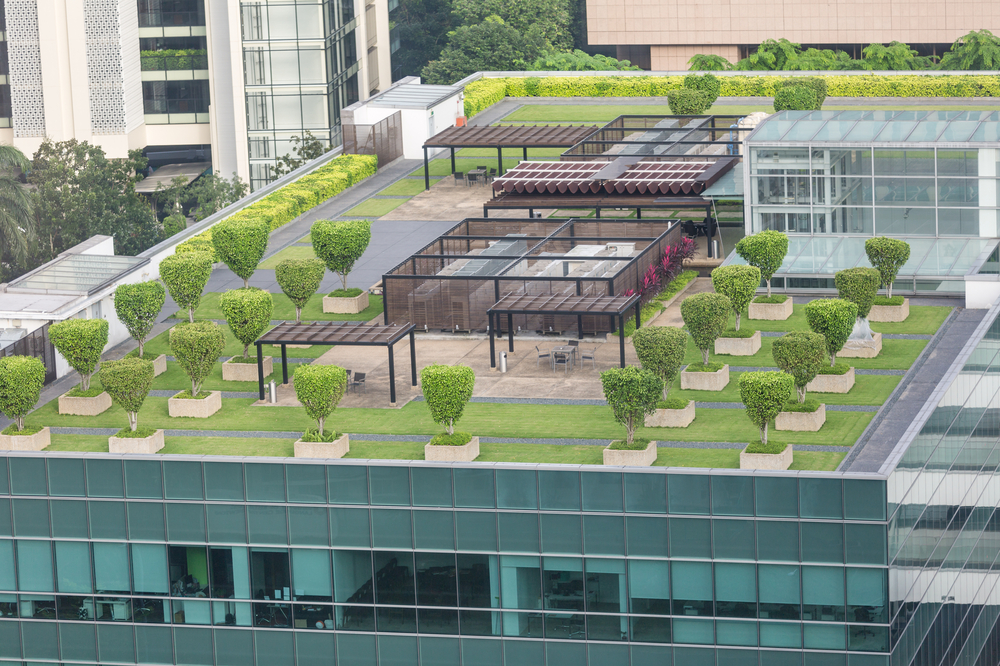Green roofs, also known as rooftop gardens, are planted over a waterproofing membrane and cover a facility’s roof with vegetation. Facilities managers should consider green roofs for stormwater management and energy savings, as well as to provide rooftop gardens, educational spaces, and urban food production.

Facilities managers should also consider incorporating green roofs into new construction of commercial, industrial, educational, and governmental facilities or, when possible, add them to existing roofs. Although there are many advantages to green roofs, like how they can be custom-designed for smaller buildings to feature simpler, low-maintenance types of green roofs, there are challenges that should be considered, as well.
Advantages
Stormwater Management: According to the U.S. General Services Administration (GSA), paved or constructed surfaces in both suburban and urban areas prevent stormwater from being absorbed into the ground. As a result, pollutants from excess runoff will enter water bodies, damaging water quality. Green roofs can reduce the flow of stormwater from a roof by up to 65% and delay the flow rate by up to 3 hours.
Reduce Energy: Green roofs reduce energy use because they cool roofs by providing shade, thermal mass, and insulation and create cool temperatures both inside and outside. The National Park Service estimates that throughout a green roof’s estimated life span of 40 years, it could save about $200,000, two-thirds of which would come from reduced energy costs. Green roofs also reduce the energy created by urban heat islands, created when concrete and asphalt absorb solar radiation, leading to increased energy consumption, heat-related illnesses and death, and air pollution.
Biodiversity: Green roofs create a new urban habitat for plants and animals that can increase biodiversity, which, according to Living Roofs.org, can include insects, flowers, dry grasslands, and ground-nesting birds. Green roofs that are designed for biodiversity should have a variety of substrate depths, and a wide range of sunflowers should be planted in addition to 50% native and 50% non-native plants of known value to wildlife.
Looking Better Longer: Because roof vegetation can usually be seen from the ground, green roofs add beauty and value to a facility, which can be especially beneficial in urban settings. Additionally, this beauty and value last longer because green roofs are expected to last twice as long as conventional roofs, as they protect roofing materials from direct ultraviolet radiation, extreme temperatures, and other weather events, which also means less maintenance.
Challenges
High Initial Cost: While the initial cost can vary by size, a University of Michigan study showed that the average cost to build a green roof is $556,561 versus $410,827 for a regular roof. However, these costs can vary based on size; complexity of the system; height from the ground; labor costs; and the need for elements like drains, railings, pavers, slope stabilization measures, and the growth medium and plants. It’s also important to hire professionals with experience in green roof installation.
Maintenance: The American Society for Horticultural Science says that green roof annual maintenance costs are between $0.75 and $1.50 per square foot each year compared with the average standard roof annual maintenance cost of $0.10 per square foot. Additionally, the U.S. Environmental Protection Agency (EPA) reports that typical green roof maintenance includes fertilization, irrigation, weed control, replanting (when needed), and maintaining aesthetics and public access. However, Princeton University cautions that green roofs can leak, and it can be challenging to locate these leaks when they occur.
Roof Pitch: Keep in mind that, according to the EPA, green roofs should only be installed on flat or gently sloping roofs because a steep slope would cause overland flow, uneven drainage, or the rapid drying of uphill portions. While some professionals say that green roofs could be installed on roofs with a maximum slope as high as 30 degrees, caution should be taken for any portions of the roof that aren’t completely flat.
Weight: When designing green roofs, the stormwater storage capacity and structural capacity to support the weight of the additional water should be taken into consideration. Specifically, the Washington, D.C., Department of Energy and Environment wrote that the conventional rooftop should “typically be designed to support an additional 15 to 30 pounds per square foot (psi) for an extensive green roof.” Additionally, it noted that a structural engineer, an architect, or a qualified professional should be involved with all green roof designs to ensure the building has enough structural capacity.
Conclusion
While green roofs are a smart idea for stormwater management, energy reduction, and biodiversity, as well as for aesthetics and longer-term value, facilities professionals should be prepared to deal with the potential challenges, including the high initial cost, maintenance, roof pitch, and weight.
